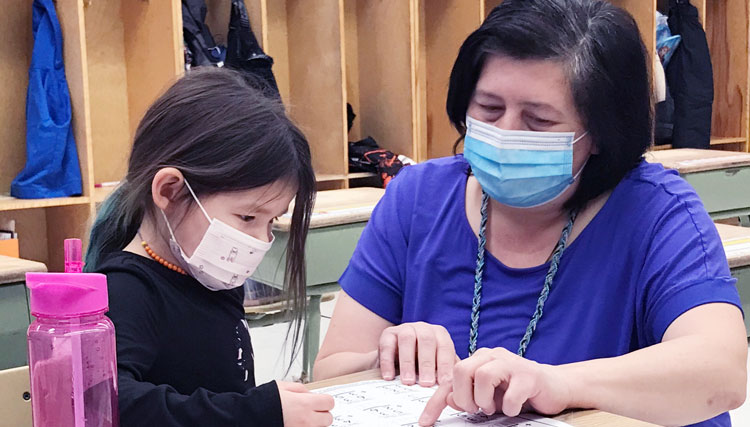
“The teachers and staff – including educational assistants, the librarian, our recreation coordinator, everybody – have gone above and beyond to think of novel ways to engage kids, to follow protocol and to make things absolutely as safe as possible.”
These were the words of Jordan Kolbeck, principal of St. Pascal School in Green Lake, when recently acknowledging the efforts put forth by teachers and staff to ensure a high level of education for the close to 90 students currently enrolled at the school.
“The sacrifices they have made when it comes to both time and energy to make these things happen has just been incredible,” Kolbeck continued. “Teachers and staff usually make such sacrifices, but in this case it was an even bigger step forward.”
Students at St. Pascal School returned to class Jan. 25 when the school returned to Level 2 of Northern Lights School Division’s Safe Schools Plan. For the first three weeks following the Christmas break, the school was at Level 4 which meant mandatory remote learning.
“It’s really been a year for opportunity and some challenges in terms of figuring out a different way to offer schooling,” Kolbeck said.”
Although there have been no positive COVID cases identified in the school, Kolbeck said it’s better to be safe than sorry, adding the mandatory online learning allowed an opportunity for students and staff to familiarize themselves with the process if there ever is a need to return to such a format going forward.
“The kids were at home and working from their Chrome books, and online through a live classroom environment,” he said. “This gave us a good opportunity to really test drive our work in terms of getting kids ready to learn online. We bought every student a Chrome book this year to get their skills up and have them ready for a potential return to online schooling if there ever were to be a transmission case in the school. This gave everyone a lot of practical experience.”
Kolbeck went on to stress the importance of still having students learning and having them engaged.
“It’s a different approach to teaching, which we need to learn as well,” he said. “We were using our Fridays for the first couple months to have kids work from home and to practice remote learning, but we transitioned to Level 2 – everyday in-class learning – after that. It was a fairly regular classroom experience and continues to be just that, social distancing and mask wearing aside of course.”
In spite of such safety measures, however, Kolbeck said classroom size has not been impacted.
“We’ve been fortunate to be a relatively small school and as such have lots of space,” he noted. “We obviously love having kids in the classrooms and seeing their faces, but the biggest challenge about doing things online is the technological issues that come up with Internet connections and last-minute computer issues.”
He also said online learning requires the need to plan things differently.
“We operate under the notion it’s probably not appropriate for a child to sit in front of a computer screen for five-and-a-half hours a day… We kind of moved that back to a couple hours of expectation allowing the kids more time to work with their families and on assignments,” he said. “Attendance was actually better online than it was in-person, which was a bit unexpected.”
Kolbeck also said teachers have done an incredible amount of learning themselves to up their 21st Century technological skills.
“Now, when I go into the classroom, it’s interesting to see some of the things they are learning,” he said. “It’s fantastic and the kids have also made leaps and bounds as far as what they can do production-wise on a computer. I’m really proud of what everybody’s done.”
by Phil Ambroziak